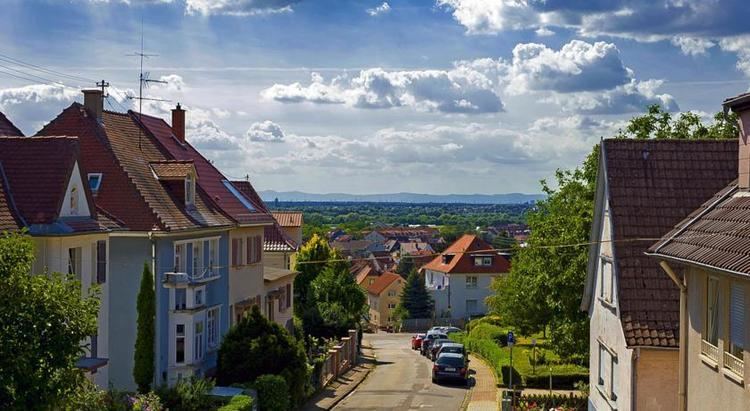Admin. region Karlsruhe Elevation 153 m (502 ft) Area 14.14 km² Local time Friday 8:31 PM Administrative region Karlsruhe | Time zone CET/CEST (UTC+1/+2) Population 12,144 (31 Dec 2008) Dialling code 06221 | |
 | ||
Weather 7°C, Wind NE at 5 km/h, 67% Humidity | ||
Dossenheim is a municipality in the Rhein-Neckar (District) in Baden-Württemberg, Germany.
Contents
- Map of Dossenheim Germany
- Location
- Boroughs
- History
- Municipal council
- Mayor
- Coat of arms
- Sister cities
- Culture and sights
- Museums
- Notable buildings and edifices
- Regular events
- Economy and infrastructure
- Transportation
- Government offices and institutions
- Clubs
- Notable natives
- References
Map of Dossenheim, Germany
It is located on Bergstrasse and Bertha Benz Memorial Route.
Location
Dossenheim lies 5 kilometers north of Heidelberg along the Bergstraße at the foot of the Odenwald. Dossenheim borders Heidelberg, Ladenburg, and Schriesheim.
Boroughs
The hamlet Schwabenheim belongs to Dossenheim.
History
Dossenheim was first mentioned in the Lorsch codex in 766. 1130 is the first mention of the noble family Wolfsölden-Schauenburg, who ruled the area from the Schauenburg. After this family died out in 1280, the inheritors sold the lands to the electors of the Palatinate of the Rhine of Heidelberg in 1303. As early as 1319, the prince-elector archbishopric of Mainz had won all the rights that the fief of Schaenberg had pawned to the knights of Handschuhsheim. After a long period of rivalry between the Archbishop of Mainz and the Palatinate of the Rhine, until Frederick I conquered the area for the Palatinate and destroyed the Schauenberg.
In the Landshut War of Succession, the Hessian landgrave destroyed Dossenheim in 1504. During the Thirty Years' War Tilly's troops, more than others, destroyed and plundered Dossenheim in 1622. After seizing the capital Heidelberg, Dossenheim belonged to the Archbishop of Mainz for a short time. However, as part of the Bergstrasse Cease-fire of 1650, Dossenheim was returned to the Palatinate. In the Dutch War and in the War of the Grand Alliance French troops set fire to numerous building in 1674, 1689, and 1693.
In 1714, Lothar Franz von Schönborn, the archbishop of Mainz renounced all claims to Dossenheim forever. In 1803 the Palatinate was dissolved and Dossenheim became part of Baden. In 1925 Schwabenheim was annexed to Dossenheim.
Municipal council
The council of Dossenheim has 22 members elected by direct suffrage for five years, in addition to the presiding mayor. The seat distribution after the local elections of 2009 is as follows:
Mayor
The Mayor is elected by direct suffrage for a term of eight years. The Mayor of Dossenheim is Hans Lorenz (CDU).
Coat of arms
The coat of arms comes from a court seal from the year 1495 upon which appeared a grape vine. In 1901 it was officially awarded by the General State Archive.
The flag is green and white. The date it was chosen is unknown.
Sister cities
Culture and sights
Local attractions include an indoor swimming pool and a little shopping center in the area Am Petrus.
Dossenheim's Kermesse (Kerwe) occurs on the third Sunday in September every year. In Dossenheimer tradition this is a street festival.
Dossenheim's location in the Rhine river flood plain at the edge of the Odenwald, offers a variety of landscapes. The agricultural landscape of the flood plain climbs steeps from 110 m above sea level through the forests of the Odenwald to 548 m at the top of the Weißer Stein (White Stone). The Weißer Stein is the site of a lookout tower made of sandstone and a broadcast tower (not the broadcast tower of SWR). The ruins of the Schauenberg to the North, offer a view over the flood plain. When the air is clear, one can see the Hambacher Schloss in the Palatinian forest and the cities of Mannheim, Ludwigshafen, Speyer, and Karlsruhe. Abandoned Porphyry quarries can be found in the wooded areas. In the Spring, fruit trees blossom white and red.
Museums
Dossenheim has a museum of local history.
Notable buildings and edifices
Regular events
Economy and infrastructure
Dossenheim is primarily a residential community. Because of its proximity to Heidelberg Dossenheim is attractive to people who work at the Ruprecht Karl University of Heidelberg, German Cancer Research Center (Deutsches Krebsforschungszentrum DKFZ) or scientific companies (located in Heidelberg Technology Park). There is limited industry and commerce in Dossenheim. Dossenheim has a history of being a stone mining village. In Dossenheim there were 2 large quarries. The raw porphyry would be transported to the transfer station with a tramway that has since been dismantled. The stone was used primarily for construction of water projects (hydraulic engineering) and road construction. Both quarries have fallen into disuse. The scars can be seen far into the flood plain of the Rhine.
Transportation
Dossenheim is on the A 5 as well as the federal highway B 3. The Upper Rhine Railway (Oberrheinische Eisenbahn, OEG), now part of Rhein-Neckar-Verkehr (RNV) GmbH, connects Dossenheim to the metropolitan centers nearby: Mannheim, Heidelberg and Weinheim. Dossenheim has 3 light rail stops: Dossenheim-Nord, Dossenheim OEG-Bahnhof and Dossenheim-Süd.
